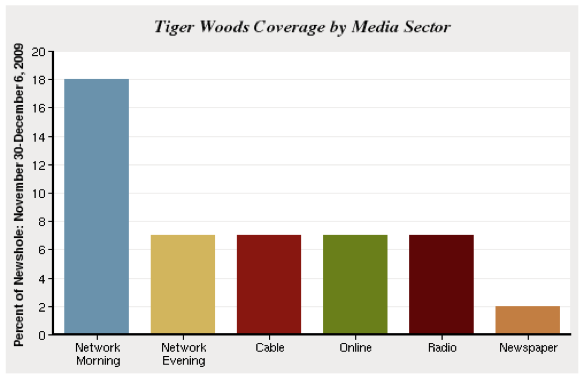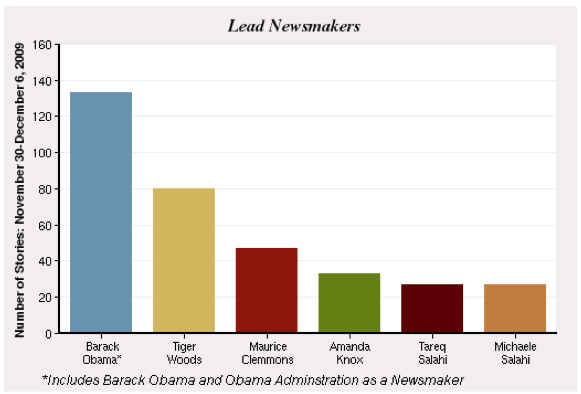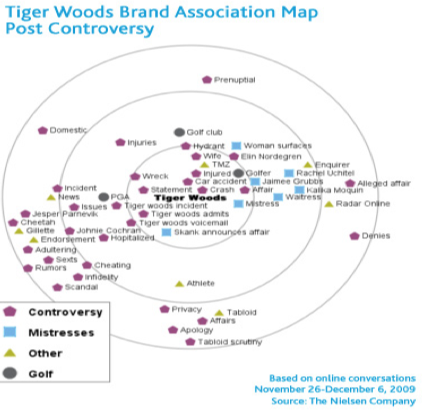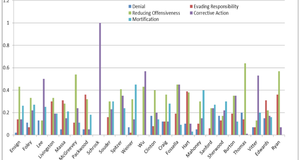From Elon Journal of Undergraduate Research in Communications VOL. 3 NO. 2Crisis Management and Sports in the Age of Social Media: A Case Study Analysis of the Tiger Woods ScandalIII. Case Study Analysis of Tiger Woods ScandalData for this research were collected through Tiger Woods' press statements following the break of his 2009 sex scandal. It included the examination of eight statements, all released from the official Tiger Woods website, that ranged from November 29, 2009, two days after the initial accident, until August 23, 2010, with the announcement of his divorce from Elin Nordegren. Of the eight statements, two were press conferences held at professional golf tournaments. The crisis management strategies used (non-existent, distance, ingratiating, mortification and suffering) within each press statement were identified and recorded. This data helped determine how often certain strategies were employed. To provide context for the case, social media feedback and news coverage reports were also examined. Overview of the Tiger Woods ScandalIn 2009, Tiger Woods, an American professional golfer, was caught amidst one of the most highprofile sex scandals of all time. Since the beginning of his professional career in 1996, Woods was regarded as one of the best—if not the best—golfer in history. He won 96 golf tournaments, 72 on the PGA tour and recorded the fastest progression to the No.1 spot on the Official World Golf Ranking ("About Tiger Woods," n.d.). Woods was estimated to be the highest paid athlete in the world in 2009, earning about $110 million (Badenhausen, 2009). Part African American, Asian, American Indian and Caucasian, Woods broke countless ethnic barriers in the sport of golf and became the face of minority athletes across the world (Davie et al., 2010). His fame and popularity made his fall from grace in 2009 that much harder. Reports of infidelity with a woman named Rachel Uchitel surfaced on Thanksgiving Day of that year from a tabloid magazine (Davie et al., 2010). It was immediately met with disbelief, but the situation became increasingly suspicious following a 2:30 a.m. car accident two days later. It was reported his wife, Elin Nordegren, was chasing his Cadillac Escalade with a golf club. Over the next several weeks, 10 other women came forward admitting to having had affairs with the married-Woods. The New York Daily News reported there were 120 allegations of adultery (Davie et al., 2010). The mistresses ranged from prostitutes to porn stars to waitresses. Woods saw several big-name sponsors like Accenture, Gillette, and Gatorade, drop him as a spokesperson, stating that he no longer represented the values of their organizations. It led to extensive media backlash, his withdrawal from tournament play, a stint in a sex rehab facility, and an eventual divorce from his wife, Elin. Crisis CriteriaThe Tiger Woods scandal meets all criteria of a typical crisis. It was a period of instability that arose from the misbehavior and indiscretions of an individual, in this case, an athlete. The crisis threatened not only reputation loss but also financial loss, as more and more sponsors chose to part ways with Woods. Media paid close attention to each twist and turn of the scandal and information spread rapidly with the availability of social media. The stories of the affairs had a significant, negative influence on public opinion. Stages of the CrisisIt is difficult to define specifically when the prodromal stage of the crisis began. The earliest report of infidelity came on November 25, 2009, from the National Inquirer. However, it is possible that there were warning signs prior to then that were not made public knowledge. There has been no discussion as to whether or not Tiger Woods' PR staff prepared a crisis management plan—likely because admitting the existence of one would imply they were aware of his indiscretions prior to the scandal. So given the knowledge available, the prodromal stage started on Thanksgiving Day and lasted for approximately two days. It marked the first ripple in Tiger's perfect public image, but at the time, the opportunity to discredit the rumor of a single affair from a non-credible source still existed. Just 48 hours later came the accident that sparked the beginning of the acute crisis stage. As mentioned, Tiger Woods left his house in the middle of the night and moments later crashed into a nearby fire hydrant. It was then that it became a full-fledged crisis. It was no longer a single allegation of an affair from the National Enquirer. There were police reports and hospital intake forms that corroborated the stories of unusual behavior. The press was immediately made aware of the accident and the crisis reached a point-ofno-return. It escalated as voicemail messages he left mistresses were leaked, and several more women came forward admitting to sleeping with him. Stories of his checking in to a sex rehabilitation facility and his unwillingness to answer the media's questions extended the length of the acute crisis stage. The Woods' scandal entered the chronic crisis stage, also known as a period of regrouping and recovering, on February 19, 2010. It was the first time Woods spoke directly to reporters since the incident. He offered an apology to his family and fans, making it clear he was ready to move on. Though a handful of sponsors continued to drop him after his public statement, no new information surrounding the scandal was released. He began granting interviews and making his way back into the professional golf circuit. Social media conversation slowly returned to talking about Woods in conjunction with golf. Some analysts and fans believe that Tiger began the crisis resolution stage on March 26, 2012, at Bay Hill with his first PGA Tour win since the scandal. Reports of "Tigers Back!" filled newspapers headlines and social media. Woods experienced a drought in victories when the crisis broke. His win in Bay Hill was a sign of restored confidence, confidence that will likely yield a return in positive media coverage and more company sponsorships. Crisis Management Strategies by StatementStatement 1, November 29, 2009: On November 29, 2009, two days after the initial crash and four days after the report of infidelity, Woods' PR staff issued their first public statement on the rumors circulating in the media ("Statement from Tiger Woods," 2009). The statement was written as a direct letter from Woods (see Table 1). By explaining the accident and the injuries he sustained from it, he took sole responsibility for its occurrence. Woods used mortification strategies, like accepting blame for the incident and apologizing, but did so referring exclusively to the car accident. He avoided any mention of infidelity and went so far as to use non-existent strategies like denial and attacking the accuser when addressing those allegations. Table 1. Statement 1. Crisis Management Strategy
Woods' initial attempt to deny indicates that his PR team likely did not have a CMP in place prior to the scandal. If they did, they would not have initially managed the crisis through outright denial. The fact he openly reprimanded the media for creating these stories when they turned out to be true is a poor reflection on Woods' credibility. It was in essence, a lie, the cardinal sin of any crisis management team. Towards the end of the statement, Woods sought to generate sympathy for him and his family by pointing out the stress these allegations have caused. Statement 2, December 2, 2009: The statement issued by Tiger Woods on December 2, 2009, (see Table 2), marked the first apology for his implied extramarital affairs ("Tiger on Current Events," 2009). Though he never specifically mentioned infidelity or cheating, he alluded to his "transgressions." He used mortification strategies at great length in the second statement. Not only did he apologize to his family and fans but made a promise to do better by both parties in the future. Table 2. Statement 2. Crisis Management Strategy Table
Woods called for the respect of his family's privacy and emphasized that whatever issues may have gone on needed to be dealt with behind closed doors, not in front of the media. To elicit feelings of sympathy from the general public, he described being followed by the paparazzi and its negative impact on his family. Woods used non-existent strategies like clarification and denial in this statement, however, not in regards to his own indiscretions, rather in an effort to absolve his wife of any blame for a physical assault. Statement 3, December 11, 2009: Woods announced on December 11, 2009, that he would be taking a hiatus from professional golf ("Woods Taking Hiatus," 2009). He stated that it was a decision he came to after much thought and that he needed to focus his attention on becoming a better husband, father, and person. It was also the first time Woods directly took responsibility for cheating, rather than just implying it. It took a total of 15 days from the time of the accident until Tiger would specify he had betrayed his wife, a period of silence that would earn him heavy public criticism. He used mortification strategies exclusively throughout the remainder of the statement (see Table 3). Table 3. Statement 3. Crisis Management Strategy Table
Statement 4, February 17, 2010: The fourth statement from Woods' staff announced that Tiger would address the media publicly for the first time since the scandal on February 19 in Ponte Vedra Beach, Fla. ("Tiger Gives Remarks," 2010). It was not a news conference, therefore, eliminating the opportunity for a question and answer period. This was the first report from Woods in more than two months, which allowed for long periods of speculation and criticism. Though it was a brief statement, his staff utilized the opportunity to employ mortification strategies like atonement and remediation once again (see Table 4). Table 4. Statement 4. Crisis Management Strategy Table
Statement 5, February 19, 2010: The speech given by Tiger Woods on February 19, 2010, was the most extensive made during the scandal ("Tiger's Public Statement," 2010). It was written and designed to signal the end of the acute crisis stage and transition into a period of recovery and regrouping. He began with more mortification strategies, primarily atoning for his sins wherever possible. Woods made an effort to not only acknowledge the hurt he caused family and fans, but his business partners as well. It is then that he included a reference to his foundation and the good work it had done in the past, an ingratiating strategy known as bolstering (See Table 5). Many media members criticized him for his attempt to pitch his foundation during a speech that was meant to center around his apology. He finally came clean about his 45-day stint from the end of December to early February in a sex rehabilitation facility during the 13-minute speech. Woods discussed his Buddhist background and how he planned to use his faith to return to a life of happiness and restraint. He included suffering strategies by drawing attention to the harm the media attention had caused his family. He stated that he would return to golf when he was ready but that it would be dependent on his progress and ability to establish balance in his life. Table 5. Statement 5. Crisis Management Strategy Table
Statement 6, March 16, 2010: On March 16, 2010, Woods announced that he would return to professional golf at the Masters ("Tigers Return," 2010). He reminded readers of the therapy he had undergone and the efforts he made to restore his family life. Woods also offered an apology for the tournaments he had to miss as a result of his rehabilitation, the use of yet another mortification strategy (see Table 6). Table 6. Statement 6. Crisis Management Strategy Table
Statement 7, April 8, 2010: After completing day one at the Masters, Woods held a press conference open to all reporters ("Tiger's Masters Conference," 2010). It was the first time he took questions from the media since the scandal. During the duration of the interview, Tiger was able to deflect all questions that related back to the scandal and spoke specifically on his golf game. He mentioned the warm reception he received from the fans out on the course. There were no identifiable crisis management strategies used throughout the duration of the interview. Statement 8, August 23, 2010: The final statement in the 2009 Tiger Woods scandal was a joint statement by both him and his wife ("Nordegren, Woods Statement, 2010). It announced that they were divorced and that though they were no longer married, they would remain wonderful parents to their two children. The statement called for sympathy from the public, a suffering strategy, as a way to encourage others to respect their privacy and move on from the scandal (see Table 7). Table 7. Statement 8 Crisis Management Strategy Table
Social Media's Reaction to the Woods ScandalIn the days immediately following the accident, traditional media outlets allotted 2 to 7% of its coverage to the Woods scandal (see Appendix Figure 1), good for the second leading story between November 30 and December 6 (Jurkowitz, 2009). Since the details of Woods' infidelity took the back seat to President Obama's speech on the War in Afghanistan (see Appendix Figure 2), the level of traditional media coverage did not accurately reflect the fervor the Woods' scandal created among social media users. Online communications saw dramatic spikes in how often Woods' name was mentioned and how often it was mentioned on issues unrelated to golf performance. According to a Nielsen Wire report (2010), Woods' name was almost always associated with words like "cheater," "infidelity," and "crash" on social media sites (see Appendix Figure 3). This pattern continued for several weeks as Woods avoided directly addressing the public and failed to provide the media with consistent updates on his progress. The same report found that between January 29 and March 19, 2010, online conversations slowly began to return to their discussion of Woods and golf (see Appendix Figure 4). A majority of these more positive conversations were likely triggered by his first press conference on February 19. SummaryWoods relied predominately on mortification strategies to manage the crisis and restore public perception. Of the eight statements made, six included mortification strategies and often more than one instance of them. He initially employed non-existent strategies like denial when addressing rumors of infidelity, which suggests that his staff did not have a CMP in place. As more and more information regarding his indiscretions was released, he was forced to take greater ownership for the scandal and change the types of approaches used. Woods was criticized for his initial denial of the affairs and for going more than two months between statements (December 11 till February 17). A swifter approach may have shortened the length of the acute crisis stage and minimized the number of dropped sponsors. Four of the five types of crisis management strategies were incorporated into his statements throughout the lifespan of the crisis, all with the exception of distance strategies. The media drew attention to his attempt at "bolstering" with the mention of his foundation and his repeated use of suffering tactics. Traditional media coverage was common, but not as potent as the discussion of the scandal on social media. Woods' name was mentioned frequently in association with his wrongdoings up until his first press conference. Though it may have been a prolonged process, research indicates that discussion of Woods and the scandal has died down on social media sites. Woods' slightly restored image has landed him two new sponsorships with Rolex and Fuse Science Inc. since the scandal.Continued on Next Page » Suggested Reading from Inquiries Journal
Inquiries Journal provides undergraduate and graduate students around the world a platform for the wide dissemination of academic work over a range of core disciplines. Representing the work of students from hundreds of institutions around the globe, Inquiries Journal's large database of academic articles is completely free. Learn more | Blog | Submit Latest in Business & Communications |






















